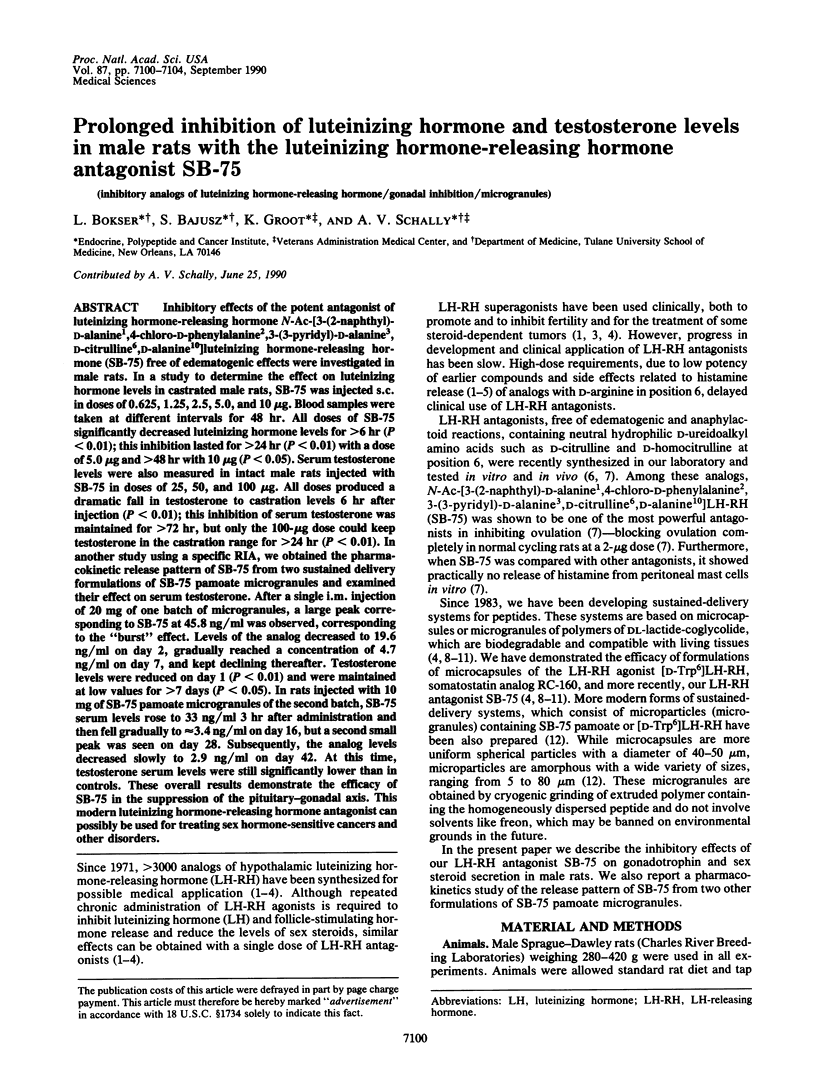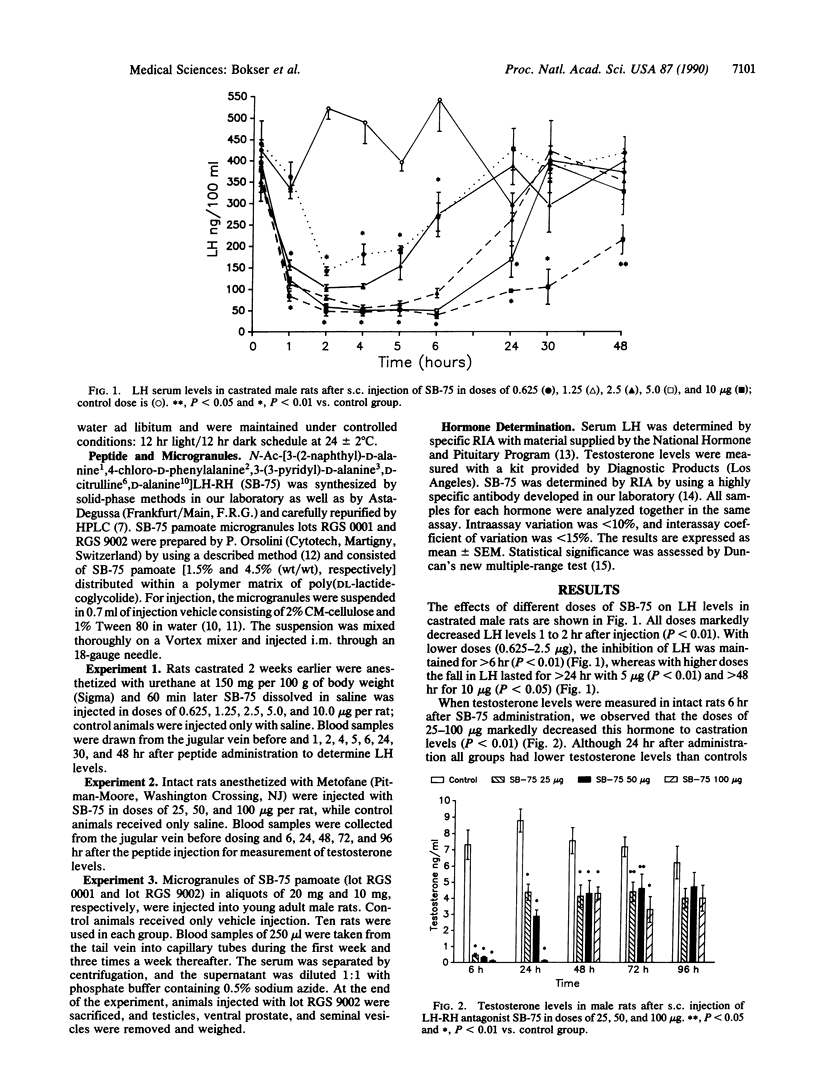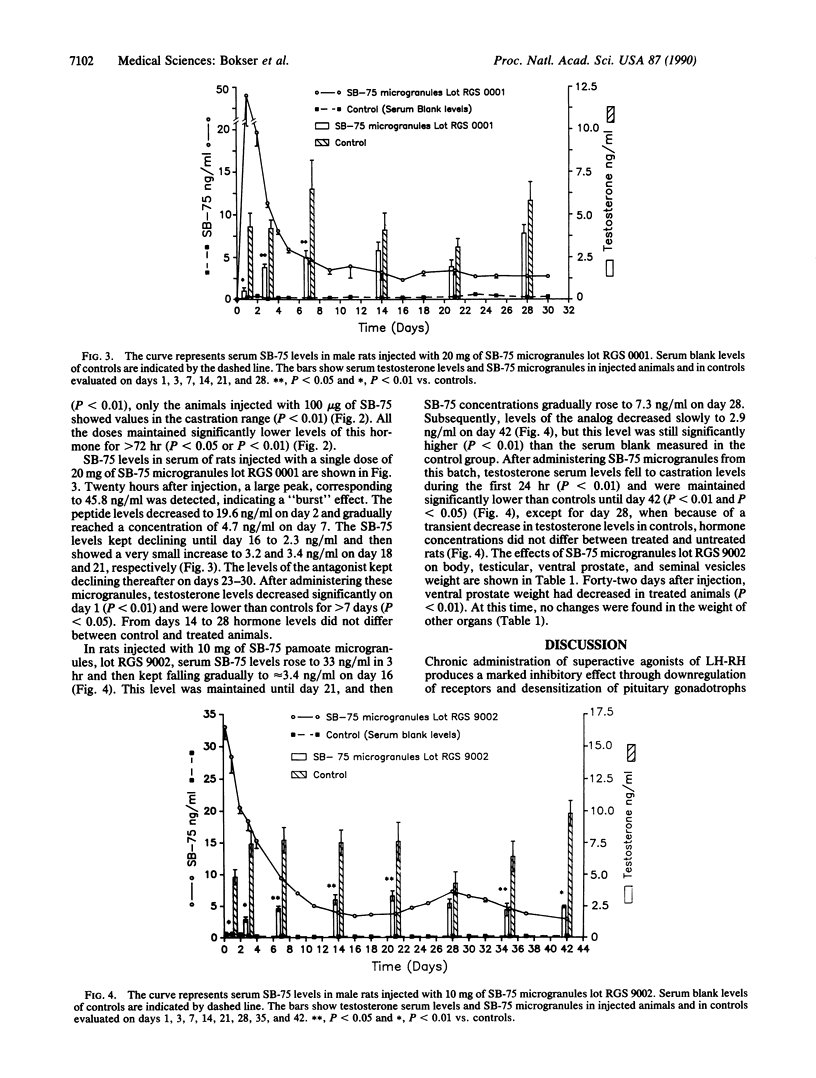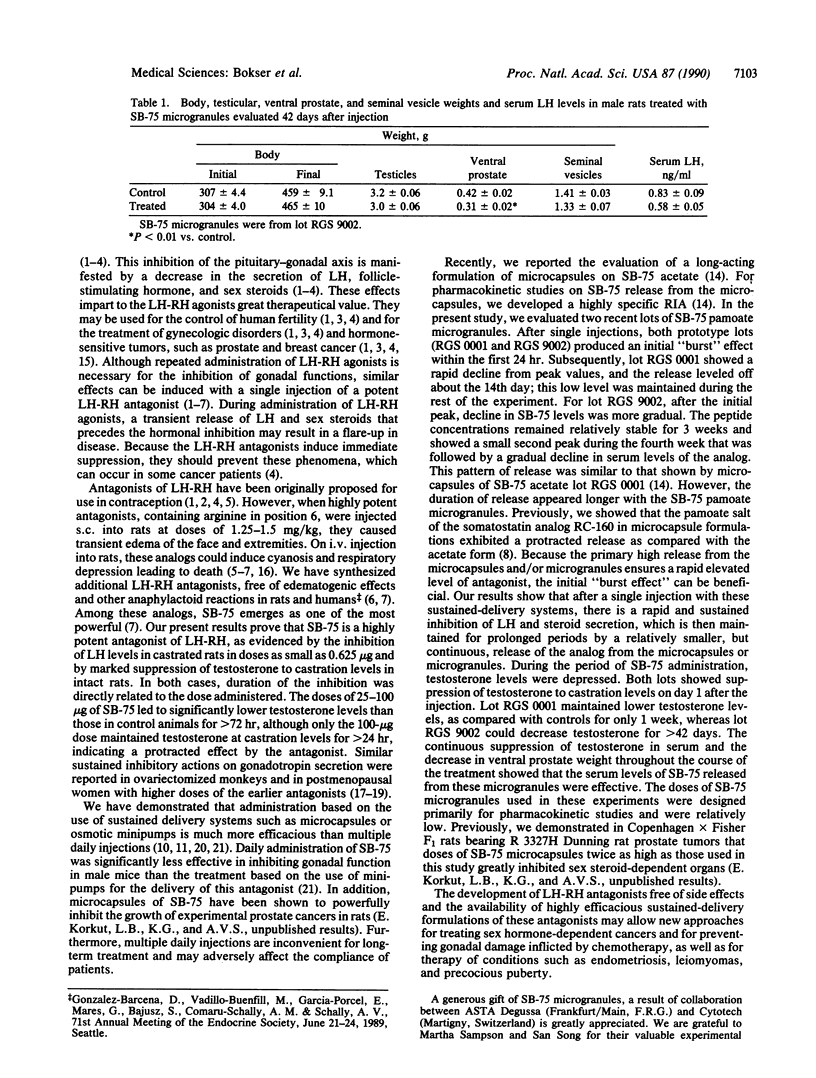Abstract
Inhibitory effects of the potent antagonist of luteinizing hormone-releasing hormone N-Ac-[3-(2-naphthyl)-D-alanine1,4-chloro-D-phenylalanine2,3- (3-pyridyl)-D- alanine3,D-citrulline6,D-alanine10]luteinizing hormone-releasing hormone (SB-75) free of edematogenic effects were investigated in male rats. In a study to determine the effect on luteinizing hormone levels in castrated male rats, SB-75 was injected s.c. in doses of 0.625, 1.25, 2.5, 5.0, and 10 micrograms. Blood samples were taken at different intervals for 48 hr. All doses of SB-75 significantly decreased luteinizing hormone levels for greater than 6 hr (P less than 0.01); this inhibition lasted for greater than 24 hr (P less than 0.01) with a dose of 5.0 micrograms and greater than 48 hr with 10 micrograms (P less than 0.05). Serum testosterone levels were also measured in intact male rats injected with SB-75 in doses of 25, 50, and 100 micrograms. All doses produced a dramatic fall in testosterone to castration levels 6 hr after injection (P less than 0.01); this inhibition of serum testosterone was maintained for greater than 72 hr, but only the 100-micrograms dose could keep testosterone in the castration range for greater than 24 hr (P less than 0.01). In another study using a specific RIA, we obtained the pharmacokinetic release pattern of SB-75 from two sustained delivery formulations of SB-75 pamoate microgranules and examined their effect on serum testosterone. After a single i.m. injection of 20 mg of one batch of microgranules, a large peak corresponding to SB-75 at 45.8 ng/ml was observed, corresponding to the "burst" effect. Levels of the analog decreased to 19.6 ng/ml on day 2, gradually reached a concentration of 4.7 ng/ml on day 7, and kept declining thereafter. Testosterone levels were reduced on day 1 (P less than 0.01) and were maintained at low values for greater than 7 days (P less than 0.05). In rats injected with 10 mg of SB-75 pamoate microgranules of the second batch, SB-75 serum levels rose to 33 ng/ml 3 hr after administration and then fell gradually to approximately 3.4 ng/ml on day 16, but a second small peak was seen on day 28. Subsequently, the analog levels decreased slowly to 2.9 ng/ml on day 42. At this time, testosterone serum levels were still significantly lower than in controls. These overall results demonstrate the efficacy of SB-75 in the suppression of the pituitary-gonadal axis. This modern luteinizing hormone-releasing hormone antagonist can possibly be used for treating sex hormone-sensitive cancers and other disorders.
Full text
PDF




Selected References
These references are in PubMed. This may not be the complete list of references from this article.
- Bajusz S., Csernus V. J., Janaky T., Bokser L., Fekete M., Schally A. V. New antagonists of LHRH. II. Inhibition and potentiation of LHRH by closely related analogues. Int J Pept Protein Res. 1988 Dec;32(6):425–435. doi: 10.1111/j.1399-3011.1988.tb01373.x. [DOI] [PubMed] [Google Scholar]
- Bajusz S., Kovacs M., Gazdag M., Bokser L., Karashima T., Csernus V. J., Janaky T., Guoth J., Schally A. V. Highly potent antagonists of luteinizing hormone-releasing hormone free of edematogenic effects. Proc Natl Acad Sci U S A. 1988 Mar;85(5):1637–1641. doi: 10.1073/pnas.85.5.1637. [DOI] [PMC free article] [PubMed] [Google Scholar]
- Bokser L., Schally A. V. Delayed release formulation of the somatostatin analog RC-160 inhibits the growth hormone (GH) response to GH-releasing factor-(1-29)NH2 and decreases elevated prolactin levels in rats. Endocrinology. 1988 Oct;123(4):1735–1739. doi: 10.1210/endo-123-4-1735. [DOI] [PubMed] [Google Scholar]
- Bokser L., Szende B., Schally A. V. Protective effects of D-Trp6-luteinising hormone-releasing hormone microcapsules against cyclophosphamide-induced gonadotoxicity in female rats. Br J Cancer. 1990 Jun;61(6):861–865. doi: 10.1038/bjc.1990.192. [DOI] [PMC free article] [PubMed] [Google Scholar]
- Bokser L., Zalatnai A., Schally A. V. Inhibition of pituitary-gonadal axis in mice by long-term administration of D-Trp-6-LHRH microcapsules. J Reprod Fertil. 1989 Mar;85(2):569–574. doi: 10.1530/jrf.0.0850569. [DOI] [PubMed] [Google Scholar]
- Csernus V. J., Szende B., Groot K., Redding T. W., Schally A. V. Development of radioimmunoassay for a potent luteinizing hormone-releasing hormone antagonist. Evaluation of serum levels after injection of [Ac-3-(2-naphthyl)-D-Ala1, D-Phe(pCl)2, 3-(3-pyridyl)-D-Ala3, D-Cit6, D-Ala10] LHRH. Arzneimittelforschung. 1990 Feb;40(2 Pt 1):111–118. [PubMed] [Google Scholar]
- Csernus V. J., Szende B., Schally A. V. Release of peptides from sustained delivery systems (microcapsules and microparticles) in vivo. A histological and immunohistochemical study. Int J Pept Protein Res. 1990 Jun;35(6):557–565. doi: 10.1111/j.1399-3011.1990.tb00262.x. [DOI] [PubMed] [Google Scholar]
- Davis M. R., Veldhuis J. D., Rogol A. D., Dufau M. L., Catt K. J. Sustained inhibitory actions of a potent antagonist of gonadotropin-releasing hormone in postmenopausal women. J Clin Endocrinol Metab. 1987 Jun;64(6):1268–1274. doi: 10.1210/jcem-64-6-1268. [DOI] [PubMed] [Google Scholar]
- Karten M. J., Rivier J. E. Gonadotropin-releasing hormone analog design. Structure-function studies toward the development of agonists and antagonists: rationale and perspective. Endocr Rev. 1986 Feb;7(1):44–66. doi: 10.1210/edrv-7-1-44. [DOI] [PubMed] [Google Scholar]
- Leal J. A., Williams R. F., Danforth D. R., Gordon K., Hodgen G. D. Prolonged duration of gonadotropin inhibition by a third generation GnRH antagonist. J Clin Endocrinol Metab. 1988 Dec;67(6):1325–1327. doi: 10.1210/jcem-67-6-1325. [DOI] [PubMed] [Google Scholar]
- Mason-Garcia M., Vaccarella M., Horvath J., Redding T. W., Groot K., Orsolini P., Schally A. V. Radioimmunoassay for octapeptide analogs of somatostatin: measurement of serum levels after administration of long-acting microcapsule formulations. Proc Natl Acad Sci U S A. 1988 Aug;85(15):5688–5692. doi: 10.1073/pnas.85.15.5688. [DOI] [PMC free article] [PubMed] [Google Scholar]
- Mortola J. F., Sathanandan M., Pavlou S., Dahl K. D., Hsueh A. J., Rivier J., Vale W., Yen S. S. Suppression of bioactive and immunoreactive follicle-stimulating hormone and luteinizing hormone levels by a potent gonadotropin-releasing hormone antagonist: pharmacodynamic studies. Fertil Steril. 1989 Jun;51(6):957–963. [PubMed] [Google Scholar]
- Niswender G. D., Midgley A. R., Jr, Monroe S. E., Reichert L. E., Jr Radioimmunoassay for rat luteinizing hormone with antiovine LH serum and ovine LH-131-I. Proc Soc Exp Biol Med. 1968 Jul;128(3):807–811. doi: 10.3181/00379727-128-33129. [DOI] [PubMed] [Google Scholar]
- Redding T. W., Schally A. V. Inhibition of mammary tumor growth in rats and mice by administration of agonistic and antagonistic analogs of luteinizing hormone-releasing hormone. Proc Natl Acad Sci U S A. 1983 Mar;80(5):1459–1462. doi: 10.1073/pnas.80.5.1459. [DOI] [PMC free article] [PubMed] [Google Scholar]
- Schally A. V., Coy D. H., Arimura A. LH-RH agonists and antagonists. Int J Gynaecol Obstet. 1980;18(5):318–324. doi: 10.1002/j.1879-3479.1980.tb00507.x. [DOI] [PubMed] [Google Scholar]
- Schmidt F., Sundaram K., Thau R. B., Bardin C. W. [Ac-D-NAL(2)1,4FD-Phe2,D-Trp3,D-Arg6]-LHRH, a potent antagonist of LHRH, produces transient edema and behavioral changes in rats. Contraception. 1984 Mar;29(3):283–289. doi: 10.1016/s0010-7824(84)80008-6. [DOI] [PubMed] [Google Scholar]
- Szende B., Redding T. W., Schally A. V. Suppression of meiosis of male germ cells by an antagonist of luteinizing hormone-releasing hormone. Proc Natl Acad Sci U S A. 1990 Feb;87(3):901–903. doi: 10.1073/pnas.87.3.901. [DOI] [PMC free article] [PubMed] [Google Scholar]
- Vickery B. H. Comparison of the potential for therapeutic utilities with gonadotropin-releasing hormone agonists and antagonists. Endocr Rev. 1986 Feb;7(1):115–124. doi: 10.1210/edrv-7-1-115. [DOI] [PubMed] [Google Scholar]


